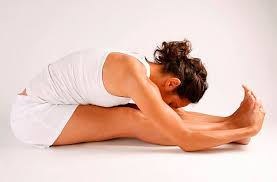Hatha Yoga Pradipika – Asanas according to Vashishtha & Matsyendranath
Vasishthadyais cha munibhir matsyendradyais cha yogibhih/
angikrtanyasanani kathyante kanichin maya//(Chapter -1, Verse 18).
I will proceed to explain some of the Asana accepted by adept munis like Vashishtha and Yogis such as Matsyendranath. (Chapter -1, Verse 18).
#200 hour Yoga teacher training certificate course in Bangalore
(1). Swastikasana (auspicious pose)

Janurvor antare samyak krtva padatale ubhe /
Rjukayah samasinah svastikam tat prachakshate//(Chapter -1, Verse 19).
Placing both soles of the feet on the inner side of the thighs, sitting equipoised with a straight body. This is called swastikasana). (Chapter -1, Verse 19).
(2). Gomukhasana (Cow’s Face Pose)

Savye dakshinaghulpham tu prshthaparsve niyojayet /
Dakshineapi tatha savyam ghomukham ghomukhakrtih//(Chapter -1, Verse 20).
Place the right ankle next to the left buttock and the left ankle next to the right buttock. This is gomukhasana and it looklike the face of the cow. (Chapter -1, Verse 20).
(3). Veerasana (Hero’s Pose)

Ekam padam tathaikasmin vinyased uruni sthiram /
Itarasmims tatha chorum virasanam itiritam//(Chapter -1, Verse 21).
Placing one foot by the opposite thigh and the other foot under the same thigh, its called as veerasana. (Chapter -1, Verse 21).
(4). Koormasana (Tortoise Pose)

Ghudam nirudhya ghulphabhyam vyutkramena samahitah/
Kurmasanam bhavedetaditi yogavido viduh//(Chapter -1, Verse 22).
Press the anus firmly with the ankles in the opposite direction and sit well-poised. According to the Yogis this is called as Koormasana. (Chapter -1, Verse 22).
(5). Kukkutasana (Cockerel Pose)

Padmasanam tu samsthapya janurvorantare karau /
Nivesya bhumau samsthapya vyomastham kukkutasanam//(Chapter -1, Verse 23).
By adopting Padmasana, insert the hands between the thighs and calves, planting them the hands firmly on the ground; raise the body in the air. This is called as Kukkutasana. (Chapter -1, Verse 23).
(6). Uttan Koormasana (Stretching Tortoise Pose)

Kukkutasanabandhastho dorbhyam sambadya kandharam/
Bhaved kurmavad uttana etad uttanakurmakam//(Chapter -1, Verse 24).
By adopting Kukkutasana, unite both the hands at the shoulders and lie flat on the back like a tortoise. This is called as Uttankoormasana. (Chapter -1, Verse 24).
(7). Dhanurasana (Bow Pose)

Padanghushthau tu panibhyam ghrhitva sravanavadhi /
Dhanurakarshanam kuryad dhanurasanam uchyate//(Chapter -1, Verse 25).
Holding the toes with the hands, pull them up to the ears as if drawing a bow. This is called Dhanurasana. (Chapter -1, Verse 25).
(8). Matsyendrasana (Spinal Twist Pose)

Vamoru mularpitadakshapadam Janor bahir veshtitavamapadam/
Praghrhya tishthet parivartitangghah srimatysanathoditam asanam syat//(Chapter -1, Verse 26).
Place the right foot at the base of the left thigh, the left foot at the side of the right knee. Take hold of the left foot with the right hand, pass the left arm behind the waist and remain with the body turned. This asana is explained by Sri Matsyendranath. (Chapter -1, Verse 26).
Matsyendrapitham jatharapradiptim Prachandarughmandalakhandanastram/
Abhyasatah kundaliniprabodham Chandrasthiratvam cha dadati pumsam//(Chapter -1, Verse 27).
Practice of this asana Matsyendrasana increases the digestive fire to such an incredible capacity, this will eradicate all stomach diseases and thus awakening the serpent power and bringing equilibrium in the Bindu. (Chapter -1, Verse 27).
(9). Paschimottanasana (Back Stretching Pose)

Prasarya padau bhuvi dandarupau Dorbhyam padaghradvitayam ghrhitva/ Januparinyastalalatadeso Vasedidam paschimatanamahuh.// (Chapter -1, Verse 28).
Stretching the legs in front on the ground, like a stick; bending forward, holding the toes with both hands and placing the forehead on the knees, is known as Paschimottanasana. (Chapter -1, Verse 28).
Paschimottanasana
Iti paschimatanamasanaghryam Pavanam paschimavahinam karoti/ Udayam jatharanalasya kuryad Udare karsyamaroghatam cha pumsam//(Chapter -1, Verse 29).

Paschimottanasana is the best among asanas. By this asana the pranic currents rise through sushumna, the digestive fire stimulates, the abdomen becomes flat, and the practitioner becomes free from all kind of diseases. (Chapter -1, Verse 29).
(10). Mayurasana (Peacock Pose)

Dharam avashtabhya karadvayena Tatkurparasthapitanabhiparsvah/
Uchchasano dandavad utthitah san Mayuram etat pravadanti pitham//(Chapter -1, Verse 30).
Lie down on the stomach, placing both hands on the ground under the body and place the elbows at the sides of the navel. Raise the body high, keeping it like a stick. This is called peacock pose by the expert Yogis. (Chapter -1, Verse 30).
Harati sakalaroghanasu ghulmodaradin Abhibhavati cha doshanasanam srimayuram/
Bahu kadasanabhuktam bhasma kuryadasesham Janayati //
jatharaghnim jarayetkalakutam/(Chapter -1, Verse 31).
Mayurasana quickly alleviates all diseases like enlargement of the glands, dropsy and other stomach disorders. It rectifies imbalance of the humors (vata, pitta, kapha). It reduces to ashes all food taken indiscriminately, kindles the gastric fire and enables destruction of deadly poison). (Chapter -1, Verse 31).
(11). Shavasana (Corpse Pose)

Uttanam sabavad bhumau sayanam tat savasanam/
Savasanam srantiharam chittavisrantikarakam//(Chapter -1, Verse 32).
Lying flat on the ground with the face upwards, in the manner of a dead body, is savasana. It removes tiredness and enables the mind-body complex to relax deeply. (Chapter -1, Verse 32).
